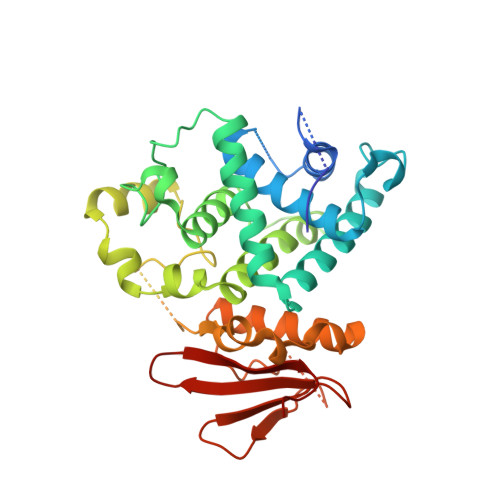The crystal structure of insecticidal protein Txp40 from Xenorhabdus nematophila reveals a two-domain unique binary toxin with homology to the toxin-antitoxin (TA) system.
Kinkar, O.U., Kumar, A., Prashar, A., Yadav, B., Hadapad, A.B., Hire, R.S., Makde, R.D.(2023) Insect Biochem Mol Biol 164: 104045-104045
- PubMed: 38040266
- DOI: https://doi.org/10.1016/j.ibmb.2023.104045
- Primary Citation of Related Structures:
7XBJ - PubMed Abstract:
Txp40 is a ubiquitous, conserved, and novel toxin from Xenorhabdus and Photorhabdus bacteria, toxic to a wide range of insect pests. However, the three-dimensional structure and toxicity mechanism for Txp40 or any of its sequence homologs are not yet known. Here, we are reporting the crystal structure of the insecticidal protein Txp40 from Xenorhabdus nematophila at 2.08 Å resolution. The Txp40 was structurally distinct from currently known insecticidal proteins. Txp40 consists of two structurally different domains, an N-terminal domain (NTD) and a C-terminal domain (CTD), primarily joined by a 33-residue long linker peptide. Txp40 displayed proteolytic propensity. Txp40 gets proteolyzed, removing the linker peptide, which is essential for proper crystal packing. NTD adopts a novel fold composed of nine amphipathic helices and has no shared sequence or structural homology to any known proteins. CTD has structural homology with RNases of type II toxin-antitoxin (TA) complex belonging to the RelE/ParE toxin domain superfamily. NTD and CTD were individually toxic to Galleria mellonella larvae. However, maximal toxicity was observed when both domains were present. Our results suggested that the Txp40 acts as a two-domain binary toxin, which is unique and different from any known binary toxins and insecticidal proteins. Txp40 is also unique because it belongs to the prokaryotic RelE/ParE toxin family with a toxic effect on eukaryotic organisms, in contrast to other members of the same family. Broad insect specificity and unique binary toxin complex formation make Txp40 a viable candidate to overcome the development of resistance in insect pests.
- Homi Bhabha National Institute, Anushaktinagar, Mumbai, 400094, Maharashtra, India; Beamline Development and Application Section, Bhabha Atomic Research Centre, Mumbai, 400085, Maharashtra, India. Electronic address: omkarkinkar1234@gmail.com.
Organizational Affiliation:
















